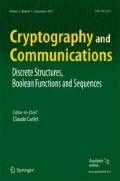Abstract
Almost complementary pairs (ACPs) are sequence pairs having zero aperiodic autocorrelation sums at all non-zero time-shifts except only one position. These are generalizations of the well-known Golay complementary pairs (GCPs). To date, known ACPs have been constructed via standard Golay sequences (GSs). In this paper, we construct novel quaternary and 16-QAM ACPs of non-power-of-two lengths based on non-standard GSs. It turns out that the peak-to-mean envelope power ratios (PMEPRs) of the proposed ACPs are upper bounded by 3.34. Due to their good correlation and low PMEPR properties, ACPs could be used as an alternative to GCPs in practical applications.
Similar content being viewed by others
References
Chang, C.Y., Li, Y., Hirata, J.: New 64-QAM Golay complementary sequences. IEEE Trans. Inf. Theory 56(5), 2479–2485 (2010)
Chong, C.V., Venkataramani, R., Tarokh, V.: A new construction of 16-QAM Golay complementary sequences. IEEE Trans. Inf. Theory 49 (11), 2953–2959 (2003)
Davis, J.A., Jedwab, J.: Peak-to-mean power control in OFDM, Golay complementary sequences, and Reed-Muller codes. IEEE Trans. Inf. Theory 45(7), 2397–2417 (1999)
Fiedler, F., Jedwab, J.: How do more Golay sequences arise. IEEE Trans. Inf. Theory 52(9), 4261–4266 (2006)
Fiedler, F., Jedwab, J., Parker, M.G.: A framework for the construction of Golay sequences. IEEE Trans. Inf. Theory 54(7), 3114–3129 (2008)
Lee, H., Golomb, S.W.: A new construction of 64-QAM Golay complementary sequences. IEEE Trans. Inf. Theory 52(4), 1663–1670 (2006)
Lee, H., Golomb, S.W.: A new construction of 16-QAM near complementary sequences. IEEE Trans. Inf. Theory 56(11), 5772–5779 (2010)
Li, Y.: A construction of general QAM Golay complementary sequences. IEEE Trans. Inf. Theory 56(11), 5765–5771 (2010)
Li, Y., Chu, W.B.: More Golay sequences. IEEE Trans. Inf. Theory 51(3), 1141–1145 (2005)
Li, Y., Kao, Y.C.: Structures of non-GDJ Golay sequences. IEEE Int. Symp. Inf. Theory 2005, Adelaide, Australia, pp. 378–381 (2005)
Liu, Z., Guan, Y.L.: 16-QAM Almost-complementary sequences with low PMEPR. IEEE Trans. Commun. 64(2), 668–679 (2016)
Liu, Z., Li, Y., Guan, Y.: New constructions of general QAM Golay complementary sequences. IEEE Trans. Inf. Theory 59(11), 7684–7692 (2013)
Liu, Z., Parampalli, U., Guan, Y.L.: On even-period binary Z-complementary pairs with large ZCZs. IEEE Signal Process. Lett. 21(3), 284–287 (2014)
Liu, Z., Parampalli, U., Guan, Y.L.: Optimal odd-length binary Z-complementary pairs. IEEE Trans. Inf. Theory 60(9), 5768–5781 (2014)
Parker, M.G., Tellambura, C.: Generalised Rudin-Shapiro constructions. Proc. Workshop Coding Cryptogr. (WCC), Pairs, France, pp. 364–374 (2001)
Paterson, K.G.: Generalized Reed-Muller codes and power control in OFDM modulation. IEEE Trans. Inf. Theory 46(1), 104–120 (2000)
Rößing, C., V. Tarokh: A construction of OFDM 16-QAM sequences having low peak powers. IEEE Trans. Inf. Theory 47(5), 2091–2094 (2001)
Schmidt, K.U.: On cosets of the generalized first-order Reed-Muller code with low PMEPR. IEEE Trans. Inf. Theory 52(7), 3220–3232 (2006)
Yu, N.Y., Gong, G.: Near-complementary sequences with low PMEPR for peak power control in multicarrier communications. IEEE Trans. Inf. Theory 57(1), 505–513 (2011)
Zeng, F., Qian, L., Zhang, Z.: Construction of 16-QAM complementary sequences from non-standard generalized boolean functions. 2014 Sixth Int. Conference on Wireless Commun. and Signal Processing (WCSP), Hefei, pp. 1–6 (2014)
Zhou, Y., Zhou, Z., Yang, Y.: 4Q-QAM complementary sequence sets with non-power-of-two length. 2019 Ninth Int. Workshop on Signal Design and its App. in Commun. (IWSDA), Dongguan, China, pp. 1–5 (2019)
Zhou, Y., Zhou, Z., Yang, Y., Wang, Y.: Two constructions for 16-QAM complementary sequence sets with non-power-of-two length. Cryptogr. Commun. 12(3), 349–362 (2020)
Acknowledgements
The authors are very grateful to the reviewers and the Editor for their valuable comments and suggestions that improved the presentation and quality of this paper. This work was supported by National Natural Science Foundation of China under Grants 62171389 and 62131016, and also by the Central Government Funds for Guiding Local Scientic and Technological Development under Grant 2021ZYD0001.
Author information
Authors and Affiliations
Corresponding author
Additional information
Publisher’s note
Springer Nature remains neutral with regard to jurisdictional claims in published maps and institutional affiliations.
Rights and permissions
About this article
Cite this article
Li, M., Zhou, Y., Su, W. et al. Constructions of almost complementary pairs based on non-standard Golay sequences. Cryptogr. Commun. 15, 95–110 (2023). https://doi.org/10.1007/s12095-022-00555-w
Received:
Accepted:
Published:
Issue Date:
DOI: https://doi.org/10.1007/s12095-022-00555-w
Keywords
- Golay complementary pair (GCP)
- Almost complementary pair (ACP)
- QAM
- Peak-to-mean envelope power ratio (PMEPR)


